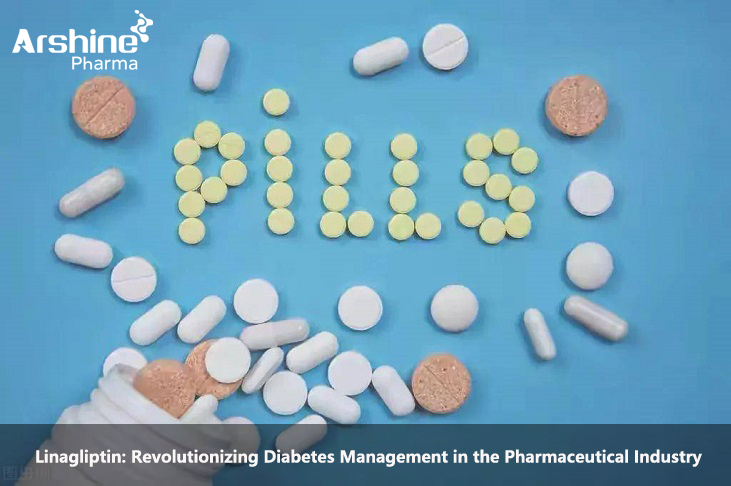Introduction
In the ever-evolving landscape of diabetes management, Linagliptin has emerged as a transformative medication in the pharmaceutical industry. As a dipeptidyl peptidase-4 (DPP-4) inhibitor, Linagliptin offers a novel therapeutic approach for treating type 2 diabetes mellitus. This comprehensive analysis explores the characteristics, mechanism of action, pharmacological profile, clinical applications, safety, and future prospects of Linagliptin, highlighting its significance in the relentless pursuit of improved diabetes care.
1. Characteristics of Linagliptin
Linagliptin, marketed under the brand name Tradjenta, is a once-daily, orally administered antidiabetic agent. It is a highly selective, competitive inhibitor of DPP-4, an enzyme that rapidly degrades the incretin hormones glucagon-like peptide-1 (GLP-1) and glucose-dependent insulinotropic polypeptide (GIP). The unique characteristics of Linagliptin lie in its prolonged duration of action and its primary excretion through the hepatobiliary route, which renders dose adjustment unnecessary in patients with mild to moderate renal impairment.
2. Mechanism of Action
The therapeutic effect of Linagliptin is based on its ability to inhibit DPP-4 activity. GLP-1 and GIP are incretin hormones secreted by the intestine in response to nutrient ingestion. These hormones stimulate insulin secretion from pancreatic beta cells in a glucose-dependent manner, which helps regulate blood glucose levels. However, their action is short-lived due to rapid degradation by DPP-4. Linagliptin intervenes in this process by inhibiting DPP-4, leading to increased and prolonged GLP-1 and GIP activity. Consequently, insulin secretion is potentiated, and glucagon release is diminished, resulting in improved glycemic control.
3. Pharmacological Profile
3.1 Pharmacokinetics
Linagliptin exhibits favorable pharmacokinetics, characterized by rapid absorption after oral administration. It reaches peak plasma concentrations within 1 to 2 hours post-dose. Unlike some other antidiabetic medications, Linagliptin has a low potential for drug-drug interactions due to its limited involvement in the cytochrome P450 metabolic pathway. The majority of Linagliptin is excreted unchanged through the bile, making it suitable for patients with renal impairment.
3.2 Pharmacodynamics
Linagliptin's primary action involves the enhancement of GLP-1 and GIP activity, leading to glucose-dependent insulin secretion and reduced glucagon release. This mechanism of action contributes to its efficacy in lowering both fasting and postprandial blood glucose levels. Additionally, Linagliptin has been associated with modest reductions in HbA1c levels, making it a valuable option in the management of type 2 diabetes.
4. Clinical Applications
4.1 Monotherapy
As a monotherapy agent, Linagliptin is indicated for use in patients with type 2 diabetes who are inadequately controlled by diet and exercise alone. When lifestyle modifications are insufficient to maintain glycemic targets, Linagliptin offers a safe and effective option to improve blood glucose control.
4.2 Combination Therapy
Linagliptin is often prescribed in combination with other antidiabetic agents to achieve better glycemic control. It can be used alongside metformin, sulfonylureas, thiazolidinediones, and insulin. Combining Linagliptin with these agents provides a synergistic effect in lowering blood glucose levels, and its once-daily dosing regimen improves patient compliance.
4.3 Cardiovascular Benefit
In recent years, there has been growing evidence of the cardiovascular benefits of Linagliptin in patients with type 2 diabetes. Clinical trials have shown that Linagliptin does not increase the risk of major adverse cardiovascular events (MACE) and, in some cases, may even offer cardioprotective effects. These findings have further solidified the role of Linagliptin as a valuable antidiabetic agent with additional cardiovascular benefits.
5. Safety
Linagliptin is generally well-tolerated, with a low incidence of adverse effects. Common side effects reported include nasopharyngitis, upper respiratory tract infections, and headache. Importantly, Linagliptin is associated with a low risk of hypoglycemia when used as monotherapy, making it a favorable option for patients prone to hypoglycemic episodes.
6. Future Prospects
As the understanding of diabetes pathophysiology and treatment continues to evolve, Linagliptin's future in the pharmaceutical industry remains promising. Ongoing research seeks to explore its use in combination with other emerging antidiabetic agents, as well as its potential application in other medical conditions. Additionally, further investigations into Linagliptin's cardioprotective effects may unlock new possibilities for its utilization beyond glycemic control.
Conclusion
Linagliptin, a potent DPP-4 inhibitor, has emerged as a transformative medication in the management of type 2 diabetes mellitus. Its unique characteristics, mechanism of action, and pharmacological profile have positioned it as a valuable option in both monotherapy and combination therapy for achieving glycemic control. The cardiovascular benefits associated with Linagliptin further underscore its significance in improving patient outcomes in type 2 diabetes.
With a favorable safety profile and ongoing research, Linagliptin's future in the pharmaceutical industry looks promising. As the industry continues to innovate, Linagliptin is likely to remain a key player in the relentless pursuit of effective and safe therapies for diabetes management. Its impact on patient care and the field of diabetes treatment as a whole reaffirms Linagliptin's vital role in transforming the lives of individuals living with type 2 diabetes and propels the pharmaceutical industry forward in the fight against this global epidemic.
